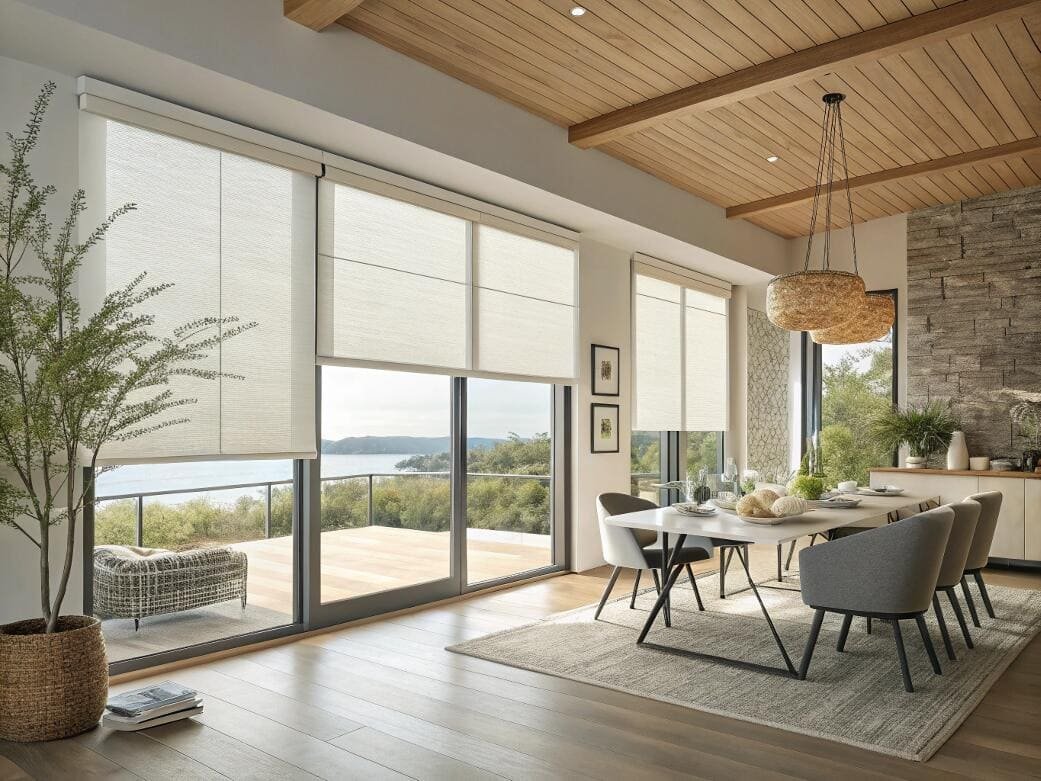Considering motorized blinds for a project but worried about the power source? The thought of tearing open walls for wiring or constantly changing batteries is enough to cause headaches.
Many modern motorized blinds[^1] use long-lasting rechargeable batteries, eliminating the need for constant replacement or a dedicated outlet. Other options include direct hardwiring[^2], plug-in adapters, and even solar power, offering a solution for every installation scenario.

I often get questions from project buyers like Emma about the practicalities of motorized blinds. The biggest concern is usually power. The great news is that technology has come a long way. Gone are the days when "motorized" automatically meant calling an electrician. Today’s solutions are designed for flexibility and ease of installation, fitting seamlessly into both new builds and retrofits[^3]. Let’s dive into how these systems get their power and what that means for your project.
Do motorized blinds use batteries?
Worried that going motorized means dealing with the hassle of disposable batteries? You want a clean, wireless look without creating a recurring maintenance[^4] task.
Yes, many motorized blinds use batteries, but the best systems feature sleek, rechargeable lithium-ion battery packs. These are designed for long life and easy recharging, offering a completely wireless solution that’s both elegant and practical for any window, even those far from an outlet.

One of the biggest innovations I’ve seen in the industry is the shift from disposable AA batteries to rechargeable motors. When I'm working with designers, having a clean, wire-free installation is paramount. Rechargeable battery-powered blinds are the perfect answer. The battery is typically a slim wand or a compact pack that hides away neatly inside the blind's headrail, making it completely invisible. This is especially valuable for high-end residential projects[^5] where aesthetics are key. It also solves the problem of motorizing windows in tricky spots, like over a bathtub or in a skylight, where running wires would be impractical or impossible. The convenience of not needing an electrician for installation makes battery power a fast, flexible, and budget-friendly choice for many retrofit projects.
How do motorized blinds get power?
Unsure about the power requirements for your Pproject? Choosing the wrong power source can lead to unexpected installation costs or future maintenance headaches.
Motorized blinds have several power options to fit any need. The most common are rechargeable batteries[^6] for wireless convenience, hardwiring into your home's electrical system for maintenance-free power, and plug-in DC adapters for a simpler wired solution. Some models even offer solar panels.

The beauty of modern motorized blinds is the range of choices, allowing us to tailor the solution to the specific project. For a new construction or a major renovation, hardwiring is a fantastic option I often recommend. An electrician can run low-voltage wires to the windows during the build-out phase. This creates a "set it and forget it" system with a constant power supply, which is ideal for large-scale commercial installations where changing batteries across hundreds of windows would be a massive undertaking. For simpler installations or retrofits, plug-in adapters offer a reliable stream of power without the need for an electrician, as long as an outlet is nearby. And for the ultimate eco-friendly and low-maintenance setup, we can use a small solar panel that sits behind the blind, constantly topping up the battery with sunlight.
| Power Source | Best For | Installation | Maintenance |
|---|---|---|---|
| Rechargeable Battery | Retrofits, hard-to-reach windows, clean aesthetics. | DIY-friendly, no electrician needed. | Recharge every 6-12 months. |
| Hardwired | New construction, large commercial projects. | Requires a professional electrician. | Virtually none. |
| Plug-in Adapter | Windows near an existing electrical outlet. | Simple plug-in, no electrician. | None, but involves visible cords. |
| Solar Power | Sunny, south-facing windows, eco-friendly projects. | Simple connection to the motor. | Minimal, ensures continuous charge. |
How long does a motorized blind battery last?
Concerned that battery-powered blinds will mean constant recharging? You need a reliable system, not another device that’s always running out of power.
On a single charge, a motorized blind battery typically lasts for about a year with average use (one up-and-down cycle per day). [1, 22] Factors like blind size, fabric weight, and frequency of use can affect this, but you can expect to recharge only once or twice a year.

I make sure my clients understand that today's rechargeable motors are incredibly efficient. The "one year on a single charge" estimate is a solid baseline we see across most high-quality systems. A client with a large, heavy blackout shade that they operate multiple times a day might need to charge it every six to nine months. On the other hand, a small, lightweight solar shade on a guest room window that's rarely used might go for even longer than a year. The key takeaway is that charging is an infrequent event. These are not like your smartphone that needs to be plugged in every night. Modern lithium-ion batteries are designed for long-lasting, stable performance, providing months of seamless operation before a simple recharge is needed, making them a very reliable power source for almost any application.
How do I recharge my motorized blinds?
Think recharging your motorized blinds will be a difficult chore? The thought of getting up on a ladder, especially for high windows, can be a major deterrent.
Recharging is simple. Most systems use a USB-C charging cable, just like a phone. You plug one end into the charging port on the motor and the other into a standard power adapter. Some brands even offer innovative magnetic chargers or long wands to easily reach high windows without a ladder.

The manufacturers we partner with have put a lot of thought into making the recharging process as painless as possible. The charging port is usually located discreetly on the motor itself, which is housed in the headrail. For most windows, you can simply plug in the provided long charging cable and let it charge for a few hours. An indicator light will typically turn from red to green to let you know when it's fully charged. For those very high, hard-to-reach windows, the charging wand is a brilliant solution I often recommend to clients like Emma. This device is essentially a portable power bank on a stick. You charge the wand first, then simply raise it up to the motor and connect it magnetically to top up the blind’s battery. This completely eliminates the need for ladders or complicated maneuvers, making maintenance safe and effortless.
How long do motorized blinds last?
Investing in motorized blinds feels like a big step. You want to be sure that the motors and components are durable and will stand the test of time.
High-quality motorized blinds are very reliable, with an average lifespan of 5 to 10 years, comparable to manual blinds. The longevity depends on the quality of the motor and components, as well as the frequency of use. With proper care, they are a long-lasting investment.

When specifying products for a project, durability[^7] is non-negotiable. My clients expect a solution that will perform flawlessly for years, and that's what we deliver. The motors used in our blinds are engineered for quiet, smooth operation and are tested for thousands of cycles. Just like any mechanical product, its lifespan is influenced by how it's used. A blind in a high-traffic commercial space that operates ten times a day will experience more wear than one in a home bedroom. However, these systems are built to handle it. Quality materials and robust construction ensure they resist wear and tear. Regular, gentle cleaning to prevent dust buildup in the mechanism also helps extend their life. Ultimately, investing in a quality motorized system from a reputable provider ensures you get a product that is not only convenient but also a durable and reliable addition to the property.
How do different power options affect large-scale commercial installations?
Planning a large commercial project with hundreds of windows? The choice between battery and hardwired systems can have a huge impact on installation timelines and long-term maintenance costs.
For large-scale commercial installations, hardwired systems are generally superior. While the initial investment is higher due to an electrician's involvement, they eliminate long-term maintenance costs associated with recharging or replacing batteries across many units, offering unparalleled reliability for building management systems.

I recently worked with a contractor on a new office tower. We were looking at over 500 windows. The idea of tasking the maintenance staff with recharging 500+ individual blind batteries, even annually, was a non-starter. This is where a hardwired solution becomes the obvious choice. By planning for it early, the electrician can run low-voltage wiring to each window as part of the main construction, which is highly efficient. [39] This provides a consistent, reliable power source that integrates perfectly with a central building management system. You can program all blinds to raise, lower, or tilt in unison based on the time of day or sun exposure, maximizing energy efficiency. [18] While Class 2 low-voltage wiring is safe and easy to work with, it still requires professional installation, adding to the upfront project cost. However, for a commercial client, the total cost of ownership is what matters, and eliminating future labor costs for battery maintenance makes hardwiring a smarter long-term investment.
Conclusion
Motorized blinds no longer require complex wiring or disposable batteries. With long-lasting rechargeable motors, hardwired options, and solar power, there is a simple, reliable, and convenient solution for any project.
---
[^1]: Explore the advantages of motorized blinds, including convenience, aesthetics, and energy efficiency.
[^2]: Understand the hardwiring process and its advantages for permanent installations.
[^3]: Learn about the best practices for retrofitting motorized blinds in existing spaces.
[^4]: Learn about the maintenance needs of motorized blinds to ensure their longevity.
[^5]: Explore the latest trends in luxury window treatments for upscale homes.
[^6]: Learn about the technology behind rechargeable batteries and their benefits for motorized blinds.
[^7]: Find out about the durability of motorized blinds and what affects their lifespan.Partner with VelaBlinds for Your Next Project
Smart window treatments shouldn't be complicated. After working with 500+ distributors and contractors worldwide, I've streamlined the process to get you quality products, competitive pricing, and reliable support - every time.
Why project professionals choose VelaBlinds:
- ✅ Fast, Accurate Quotes - Detailed specs and pricing within 24 hours
- ✅ Transparent Pricing - No hidden fees, volume discounts clearly outlined
- ✅ Quality Assurance - Direct partnerships with certified OEM manufacturers
- ✅ Project Support - Dedicated account manager from quote to delivery
Start your next project:
📧 Quick Quote: Send your requirements to info@velablinds.com
📱 Direct Contact: WhatsApp +86 137 2012 8317
🌐 Browse Solutions: https://velablinds.com/
📁 Product Resources: Access spec sheets, catalogs & project files
Paul Chen, Founder
"I built VelaBlinds to solve the real challenges I faced as a project buyer - long lead times, unclear specs, and unreliable suppliers. Let's discuss how we can power your projects with smarter blinds."
Serving distributors and contractors across North America, Europe, and Australia since 2018.




